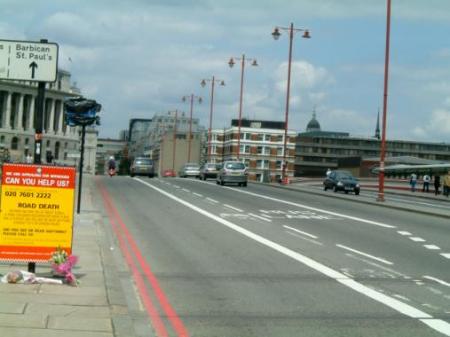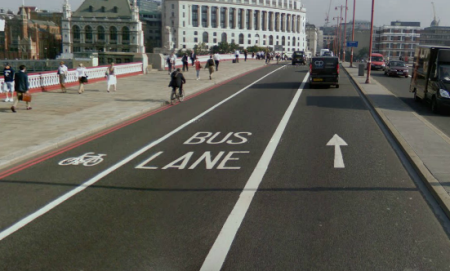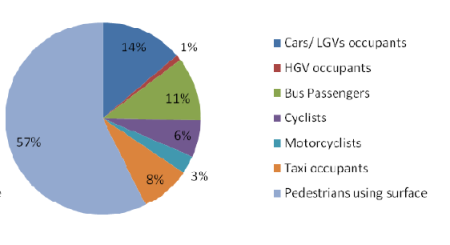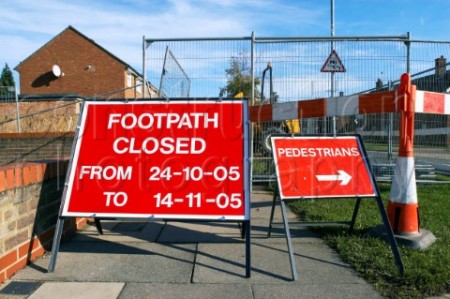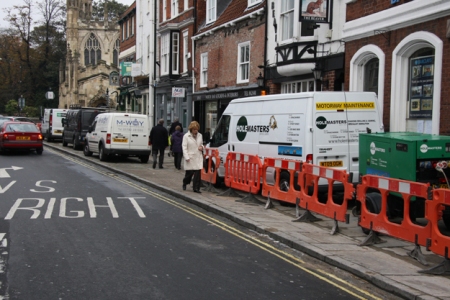In September, Transport for London released a copy of a presentation they had submitted to the London Assembly about Blackfriars Bridge.
This contained some rather extraordinary claims, for example this projection (p3):
AM peak 2012 – pedestrians 58%, cyclists 6%, car occupants 14%
Given that there are currently more cyclists than car occupants, and cycling is increasing while driving is decreasing, the above is quite clearly wrong.
Thanks to the tenacity of London Assembly Member John Biggs (and his researchers), TfL has been forced to release an explanatory note, which shows the dubious assumptions that they have made in order to arrive at these figures.
TfL’s projection in their presentation:

There are a number of sins in the explanatory note (detail below). Here are some of my favourite:
- Citing a figure from the Department for Transport’s guidelines, but actually using a different figure.
- Extrapolating about what will happen at Blackfriars based on a survey about travel in the whole of London – when we have exact figures at Blackfriars going back to 1986.
- Using a dataset from JMP consultancy, rather than TfL’s own screenline counts, where the consultancy’s figures lend more support to TfL’s argument.
- Despite cycling increasing every year at Blackfriars since 1994, assuming that there will be no increase between 2010 and 2012.
- Similarly, despite people driving cars decreasing every year since 1996, assuming that this will not change between 2010 and 2012.
A projection based on correcting the clear errors in TfL’s methodology:

Pedestrians, cyclists and bus passengers increase. Car occupants decrease. Cyclists far outnumber car occupants.
Without pedestrians, this is what this looks like:
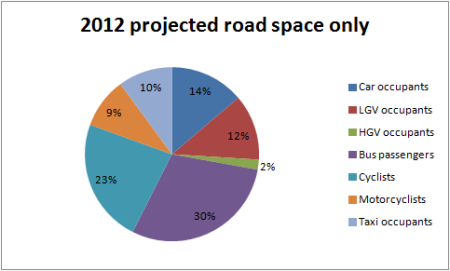
Cyclists 23%, car occupants 14%
Get the data behind this here.
I outline the errors and idiosyncrasies in TfL’s methodology that I have addressed below. TfL’s comments are in italics and mine are in bold.
Cars and LGVs
In 2007/08 there were 4033 car and LGV occupants. This is based on JMP’S January 2007 counts and an occupancy rate per vehicle of 1.63. The occupancy value is from ‘Values of Time and Operating Costs’ (April 2009) TAG Unit 3.5.6, Department of Transport.
This is calculated by adding 1400 cars to 850 LGVs and multiplying by a 1.63 occupancy rate. However, the relevant occupancy rate from the DfT TAG figures cited by TfL is not 1.63 – this is the all week average for all cars. The average per km travelled figure between 7-10am for cars is 1.37, and for LGVs is 1.23.
Using the correct figures, the number of occupants is actually 2963.
For 2012 there are assumed to be 3750 [car and LGV] occupants. This is based on modal share reported for 2007-2009 in Travel in London Report 3, where car and LGV numbers reduced by 7%.
Using the figures from a report about travel in the whole of London is an odd choice when we have exact year-on-year figures about car and LGV rates at Blackfriars back to 1986.
When we look at those figures, we see that cars have reduced by 7% over the last 2 years – so a reduction of 7% by 2012 would mean that they stayed constant between 2010 and 2012. This seems unlikely, given that car usage has decreased in every period since 1994. 7% is the smallest post-congestion charge 2 year reduction, so it seems conservative to use that for the change between 2010 and 2012.
LGVs increased 6% in the last 2 years, and stayed constant in the 2 years before that – so let’s assume a 3% increase next year.
HGVs
In 2007/08 there were 259 HGV occupants. This is based on JMP’S January 2007 counts and an occupancy rate per vehicle of 1.
Again an interesting choice of dataset – using the figures from a consultancy rather than TfL’s own screenline counts in the same year which show only 67 HGVs during rush hour.
There is nothing wrong with having two datasets, but it seems reasonable to use an average of the two for a total of 163 HGVs.
Cyclists
In 2007/08 there were 1173 cyclists. This is based on JMP’S January 2007 cycle counts which have been uplifted by 17% to reflect seasonal differences in cycle numbers.
Once again this is lower than TfL’s own screenline data (1288 cyclists) but it’s not too different so let’s accept it.
In 2012 there are assumed to be 1666 cyclists. Cycling numbers uplifted by 42%, based on modal share changes reported 2007-2009 in Travel in London Report 3.
Except once again TfL use a report for the whole of London when we have hourly data for this particular bridge for the last 25 years.
Cycling increased 40% between 2008 and 2010, so TfL are saying that it will not increase at all between 2010 and 2012 which seems highly unlikely. In four year period of 2006-2010, cycling over Blackfriars increased 100%. So once again let’s go for a reasonably conservative estimated 2008-2012 increase and say 65%.
Taxi Occupants
In 2007/08 there were 2254 occupants. This is based on JMP’S January 2007 traffic counts and an occupancy rate of 1.8 based on TfL Strategy Guidelines.
Which guidelines? We know that 1/3rd of taxis in the City are empty between 7am and 10am. So this claim means that the average occupied taxi has 2.7 passengers. A figure this high demonstrates what we already suspected: that TfL are including the driver as an occupant.
This is simply incorrect. 1000 empty taxis add nothing – in fact it’s worse than that. Indeed some might argue you should count taxis with just the driver in as worth less than 0. But let’s not, and just subtract the driver for a figure of 0.8 people per taxi.
Pedestrians, bus passengers and motorcyclists
There aren’t enough other sources of data for pedestrians or bus passengers, so we have to accept those estimates. Motorcyclists seems about right.
I am astonished that Transport for London seem to be able to get away with this. Are they accountable to anyone? This is what I’ll be asking on Wednesday, 5.45pm at Blackfriars.





